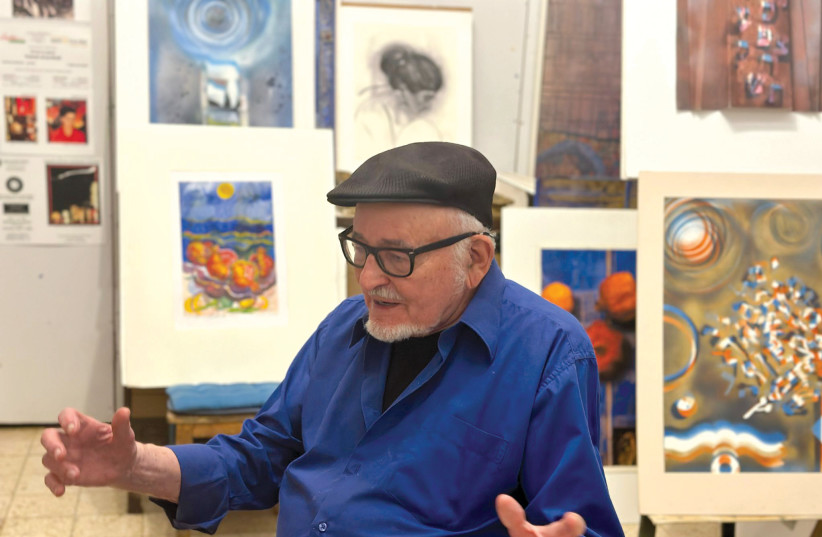“I was born in Brooklyn in 1932 during the Great Depression,” says Yitzchak Greenfield, a 91-year-old painter who lives in Ein Kerem in Jerusalem and is preparing for a new exhibition of his work.
Greenfield, who has presented exhibitions all over the world, is an Israeli success story. His father went from Transylvania to the United States in the 1920s and worked in textiles; his mother was from Galicia. Hungary (now Ukraine), who emigrated after surviving World War I.
His grandmother ran away from her home in a small town into the woods to escape the Cossacks, who raped and plundered Jews in the town. When the family returned, they found that the Cossacks had run amok over their house and turned it into a stable for their horses, but she survived. Her husband, who was a soldier in the Hungarian army, survived – only to die a few years later of influenza. So she sold the house and moved to Vienna, where there was a large Jewish community
In the 1920s she immigrated with her entire family to the US, except for one brother who had a hernia and was therefore sent back, in accordance with the immigration policy that was practiced in the States at the time. He did not survive the Holocaust. In the US, Greenfield’s mother met his father, and they got married. Greenfield has two brothers.
“At the age of two or three, I already started painting,” Greenfield recounts, saying he imagined the battles raging in World War II at the time.
As a child, Greenfield was sent to a public school but also went to a heder to study Judaism. In high school, he attended a public school with some 4,000 students, of whom 3,700 were Jews. He was the editor of the school newspaper and wrote poems and stories for it.
Outside of school, he studied art at the Educational Alliance Art School, a Jewish art school in Manhattan, because his parents encouraged him to pursue his talent. He also made contact with international artists at that time. He would help them while learning ceramic sculpture from them. He says he acquired a lot of knowledge and skills about ceramic sculpture and painting from this experience.
Learning art and Zionism
At the age of 15, Greenfield learned about a new concept -– Zionism – from friends who were in Shomer Hatzair. He joined the youth movement and says he learned a lot from the madrichim (leaders), who became like family to him.
In 1950, when he was 19 and studying at university, he decided to immigrate to Israel and join a kibbutz. He left the university and worked odd jobs to pay for his aliyah. At that time, the Jewish Agency did not help Americans, he says, because as far as the Agency was concerned, all Americans were rich. But that was not true – half of the people in his group came from families that were not rich, he says.
Throughout this period, Greenfield continued to paint. After he arrived in Israel and joined Kibbutz Galon in the Negev, the kibbutz gave him free time to paint and even hung one of his paintings in the dining room, even though it was not a socialist painting but a freestyle painting, he explains.
In Israel, he met Tzipora, a beautiful young woman from a Yemenite family, the daughter of a rabbi from Rishon Lezion. When they got married, people asked her father, “How did you let your daughter, the daughter of a rabbi, marry a kibbutznik?’ He replied, “We live in a special generation of kibbutz galuyot (ingathering of the exiles), and my daughter and Yitzchak fulfill the mitzvah of kibbutz galuyot.”
After the wedding, the couple moved to Ein Hashofet together with some friends. Greenfield won a scholarship to study art printing techniques, some of which he displays in his new exhibition, which is called “Lions and Letters.”
In the exhibition, there are Kabbalist symbols, Hebrew letters, old locks, and starfish. Greenfield’s works are an integral part of the Israeli art scene, and he has showcased his work in dozens of exhibitions around the world.
“All this was to show my light,” he says. For example, he explains, “one can interpret the text to personal connections such as country, challenges and other associations.”
Greenfield, who has also taught painting, uses random materials he finds to produce his unique art. “Everything I find, I save and use later for painting,” he says.
His personal life and Jewish life find expression in his art. A memory of the Holocaust is immortalized by leaves, while Mount Sinai is portrayed as a small mountain with large tablets.
Greenfield has five sons and dozens of grandchildren. One of his grandchildren is media personality Yoni Kedem, a well-known personality in the haredi sector who served in the IDF and worked as a digital content consultant in the election campaigns of Shas and United Torah Judaism.
“I am proud of my grandfather,” Kedem tells The Jerusalem Report. “He is an Israeli and Zionist success story, and he is part of the Israeli and Jerusalem landscape. I was blessed, and I want the whole country to know this wonderful man and the rare and wonderful works of a charming artist, whom I call Saba, ‘grandfather.’” ■













